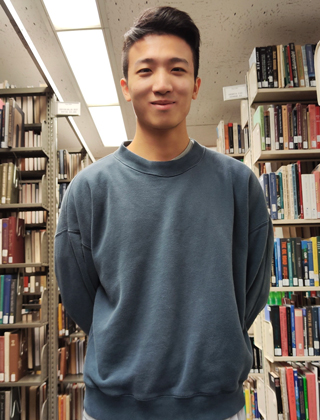


Making connections
Photo courtesy of Ziyang Jiang | Photo illustration by Jeffrey C. Chase December 15, 2022
Undergrad uses math to understand how different regions of the brain communicate
Editor’s Note: This Q&A is one of a series of articles exploring the research that University of Delaware students have been pursuing. Follow our “Frontiers of Discovery” series as UDaily highlights some of these scholars.
Ziyang Jiang is a senior applied mathematics major from the Gulou District, China. Jiang is studying how different areas of the brain learn to communicate, to decode how information gets passed from one region to another.
Q: What draws you to research? Have you done it before?
Jiang: I am a senior undergraduate student in applied math. I have learned abstract math definitions and theories in class and tested my knowledge with exams. Now, I would like to see how mathematics can be applied in research. I had planned to do some research in my sophomore year but was unable to travel back to the United States due to COVID-19.

Q: What are you studying, where are you studying, and who is your faculty mentor on this work?
Jiang: I am studying how different areas of the brain learn to communicate using a feedforward neural network model, under the advisement of Chad Guisti, assistant professor of mathematics.
Q: How would you explain your work to a non-scientist or even a fifth grader?
Jiang: My work focuses on understanding how different regions, or parts, of the brain interact. For example, when you walk into a room and see your pet, there is a visual stimulus (in one region of the brain) of your pet that might lead to, for instance, a stimulus in an emotional center of your brain. So somehow, information was passed from one region to another. We are using mathematics to understand how that happens.
Q: What are the possible real-world applications for your study?
Jiang: The goal of this project is to better understand how information propagates or spreads in a randomly wired neural network. For example, when people suffer a stroke, the original connection between neurons can be lost and information will be transmitted differently than before. If we understand how information was transmitted originally, maybe we can figure out how information is transmitted after the stroke and find solutions to correct broken connections that might have occurred.
Q: How does this experience align with your professional goals?
Jiang: I plan to pursue a career in computer science or data science. Coding and data management/analysis applied throughout my summer research project helped me enhance my coding skills in Python and build a foundation for my data science career.
Q: What do you enjoy when you are not doing research?
Jiang: When I’m not doing research, I love playing badminton, bodybuilding and hanging out with friends.
Q: What advice would you give to your fellow students who may be considering or are planning to pursue undergraduate research?
Jiang: Undergraduate research is a good way of enhancing the knowledge you learn from class and an opportunity to pursue things you are interested in. I suggest thinking over whether you like to do research and consider whether it might be useful for your future career.
Contact Us
Have a UDaily story idea?
Contact us at ocm@udel.edu
Members of the press
Contact us at 302-831-NEWS or visit the Media Relations website

